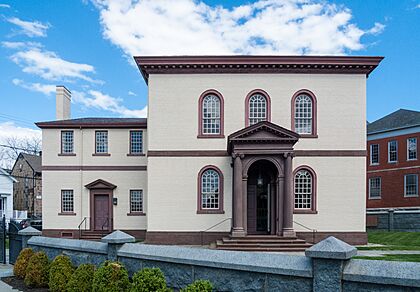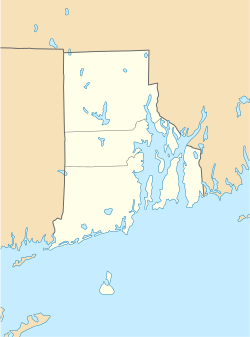Touro Synagogue facts for kids
Quick facts for kids Touro Synagogue |
|
|---|---|

Touro Synagogue, in 2017
|
|
| Religion | |
| Affiliation | Orthodox Judaism |
| Rite | Ashkenazic (Nusach Sefard) |
| Ecclesiastical or organizational status | Synagogue |
| Ownership | Congregation Shearith Israel |
| Status | Active |
| Location | |
| Location | Newport, Rhode Island |
| Country | United States |
| Architecture | |
| Architect(s) | Peter Harrison |
| Architectural type | Synagogue |
| Date established | c. 1654 (as a congregation) |
| Completed | 1763 |
| Direction of façade | East |
The Touro Synagogue is a historic Jewish house of worship built in 1763. It is located in Newport, Rhode Island. Different groups have used the building over the years. Today, the Congregation Ahavath Israel meets there.
This synagogue is very special because it is the oldest synagogue building still standing in the United States and North America. It is the only one left from the colonial era. In 1946, it was named a National Historic Site.
Touro Synagogue is an important symbol of religious freedom. This idea was very important when Rhode Island was founded by Roger Williams. Rhode Island was a safe place for people who wanted to practice their religion freely. The synagogue shows how much the colony valued religious tolerance early on.
The first group of people who worshipped here were Sephardic Jews. They likely came from the West Indies. They were part of busy trade routes connecting Dutch and English settlements. They kept their Spanish and Portuguese Jewish traditions and customs.
During the American Revolutionary War in the late 1700s, the congregation sent the synagogue's deed and holy Torah scrolls to Congregation Shearith Israel in New York for safety. Over time, more Ashkenazi people joined the congregation. This reflected changes in Jewish immigration to the United States.
In recent years, there was a legal disagreement about who owned the Touro Synagogue. In 2012, the Newport congregation wanted to sell some old items to help pay for repairs. This led to a court case with Congregation Shearith Israel. In 2017, a court decided that the New York congregation owned the synagogue. The U.S. Supreme Court did not hear the case, so that decision remained.
Contents
History of the Synagogue
The Touro Synagogue was designed by Peter Harrison. He was a famous British architect who moved to British America and lived in Rhode Island. Many people think this synagogue is his best work.
Inside, there are twelve tall Ionic columns that hold up balconies. These columns represent the twelve tribes of ancient Israel. Each column was carved from a single tree. The building faces east, towards Jerusalem, which is a common tradition for synagogues.
The ark, where the Torah scrolls are kept, is on the east wall. Above it is a painting of the Ten Commandments in Hebrew. A Newport artist named Benjamin Howland painted it.
The first Jewish group in Newport, called Shearith Israel, started in 1654. However, they left the original building during the American Revolutionary War. The Jeshuat Israel congregation began in 1658. Fifteen Spanish and Portuguese Jewish families arrived then, probably from the Dutch or British West Indies. Many of them settled near Easton's Point.
The new Touro Synagogue building was officially opened on December 2, 1763. This was done by the Jeshuat Israel congregation. Important leaders of the synagogue included Abraham Pereira Mendes and Henry Samuel Morais.
The synagogue was built between 1759 and 1763. Cantor (Chazzan) Isaac Touro, a rabbi born in the Netherlands, led the Jeshuat Israel congregation during this time. The first stone was laid by Aaron Lopez. He was a very wealthy merchant and generous person from Newport, originally from Portugal. He supported Jewish causes and made his fortune through various trade activities, including the trade of goods and people.
Judah Touro, who was Isaac Touro's son, became a rich merchant in New Orleans. In his will, he left $10,000 to help take care of the Jewish cemetery and synagogue in Newport.
In 1946, Touro Synagogue was named a National Historic Site. It is connected to the National Park Service. The synagogue was also added to the National Register of Historic Places on October 15, 1966. In 2001, the congregation started working with the National Trust for Historic Preservation.
The Touro Synagogue is located at 85 Touro Street. It is still an active Orthodox synagogue today. The building was repaired and updated in 2005 and 2006. In 2013, they held a special event to celebrate its 250th anniversary, recreating the original dedication ceremony.
Washington's Letter on Religious Freedom
On August 18, 1790, President George Washington visited Newport. He was touring New England after Rhode Island had approved the U.S. Constitution. He met with different religious groups, including Christians, Freemasons, and the Touro Synagogue congregation.
Moses Seixas, a leader of the Touro Synagogue, wrote a letter to Washington. He expressed the congregation's support for Washington's leadership. Washington wrote back on August 21. Part of his letter said:
... the Government of the United States ... gives to bigotry no sanction, to persecution no assistance. ... May the children of the Stock of Abraham, who dwell in this land, continue to merit and enjoy the good will of the other Inhabitants; while every one shall sit in safety under his own vine and fig tree, and there shall be none to make him afraid. May the father of all mercies scatter light and not darkness in our paths, and make us all in our several vocations useful here, and in his own due time and way everlastingly happy.
Every year, the Touro congregation reads President Washington's letter. They celebrate this event with special guest speakers. Past speakers have included Supreme Court justices Ruth Bader Ginsburg and Elena Kagan. Presidents of Brown University, Ruth Simmons and Christina Paxson, have also spoken.
As of June 2011, the original letter is owned by the Morris Morgenstern Foundation. It is valued between $5 million and $10 million.
The Congregation
The first Jewish people in Newport arrived in 1658. There were fifteen Spanish Jewish families. They likely came from communities in Curaçao or Suriname. Curaçao has the oldest active Jewish congregation in the Americas, started in 1651.
For over a hundred years, the small community worshipped in private homes. They could not afford to build a synagogue until much later. In 1677, the community bought and dedicated the Jewish Cemetery at Newport.
In the late 1700s, the Jewish community sent their Torah scrolls and the building's deed to Congregation Shearith Israel in New York for safekeeping. The keys to the synagogue were given to the Goulds, a Quaker family in Newport.
From the 1850s, the building was sometimes opened for worship. This was for people visiting in the summer. It started opening regularly again in 1883. This happened as Jewish life in Newport grew with new immigrants from eastern Europe. These were mostly Ashkenazim.
The synagogue bought a nearby building. They started a Hebrew school and other activities. Today, it is still a busy congregation with many programs all year round. The congregation currently uses the ArtScroll Nusach Sefard prayer book.
Rabbi Dr. Marc Mandel became the rabbi in July 2012. As of 2012, the congregation had about 175 families. Rabbi Stephen Belsky served as interim rabbi from 2023 to 2025.
Restoration Work
In 2005 and 2006, Touro Synagogue worked on restoring its old metal items. There were 150 metal objects in total. These included hardware from the 1700s, European chandeliers, and silver rimonim. Rimonim are ceremonial bells used on the Torah.
These items needed to be rebuilt, cleaned, and have missing parts replaced. A restoration company in Newport called Newmans Ltd. did this important work.
Images for kids
-
The adjacent Levi H. Gale House is used by Congregation Jeshuat Israel.
See also
- Touro Cemetery
- Touro Synagogue (New Orleans)
- Kahal Kadosh Beth Elohim
- Partners for Sacred Places
- List of the oldest synagogues in the United States
- National Register of Historic Places listings in Newport County, Rhode Island








